By Joel Tolman
Director of Impact & Engagement
Last Wednesday, when Common Ground teachers would normally be sitting down to our weekly faculty meeting, we were instead piling into cars and heading out into our immediate West Rock neighborhood.
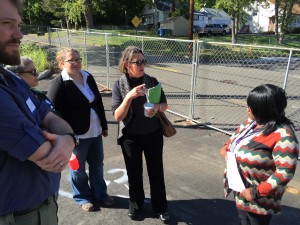
Dilias Ratchford talks with Common Ground staff next to the fence that separates New Haven from Hamden.
- Some of us stopped by to visit with Dilias Ratchford, the mom of a recent Common Ground graduate, who shared efforts to connect the newly renovated Rockview public housing development with public transit and a grocery store – and to remove of the fence that still separates New Haven from Hamden.
- Others headed for the West Rock Nature Center to talk with Ranger Joe Milone about how we can keep breathing life back into what’s likely the nation’s oldest urban nature center.
- Staff ventured up the street to Solar Youth, the amazing youth development organization whose offices are located in Westville Manor housing project, and traded educational experiences with program director Gammy Moses.
- We sat down with Ms. Gay, who runs the Family Resource Center at Katherine Brennan K-8 School, and explored the school garden that Common Ground students and staff have helped Ms. Gay to create.
- We talked as well with Emily Byrne at the New Haven Housing Authority, figuring out how we can work together to get students living in public housing the educational supports they need and deserve.
After scattering to these different locations, we re-convened at the West Rock Community Center to share observations, discuss how we might integrate these places into our curriculum, and – most importantly – be good neighbors to the other people who call West Rock home.
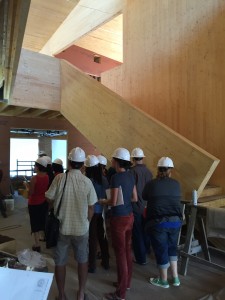
Common Ground staff explore inside our new school building — and discuss what learning opportunities this building can create.
On another Wednesday a month earlier, Common Ground’s staff went exploring closer to home. Half of us donned hard hats and ventured inside the construction fence at the base of Common Ground’s campus. We circled up under the soaring cross-laminated timber rafters of our new multi-purpose space, walked through future science labs and art classrooms, and peered out windows to check out views of campus we have never seen before. The other half of us headed into Common Ground’s production gardens – nibbling tomatoes, digging in the dirt, making observations, asking ourselves what our students would notice in this place. Then, we switched roles – gardeners to the construction site, builders to the garden. In both places, teachers asked themselves and each other a simple set of questions: What do we notice? What makes us curious? How could we use this place to improve the educational opportunities we provide to our students
Something like this – a chance for Common Ground’s staff to explore the city and site that we call home – will happen once a month throughout this school year. We will walk around the rapidly changing area along Winchester Avenue, learn from the work happening at the Connecticut Center for Arts and Technology, and end up at City Climb for a little indoor rock fun. We hope to visit our peers at Sound School, walk through the Long Wharf Nature Preserve where our students have planted trees and restored habitat, and eat at the taco trucks right along New Haven Harbor. We will get together with other urban educators, share lessons and units in progress that use the city as a classroom, and provide feedback to one another.
Why do we spend our precious faculty meeting time this way? There are certainly other ways we can, and do, spend our professional learning time. We align our curriculum with state standards. We build skills for restoring our classrooms when a student has broken their norms. We look at data from school-wide assessments, and use that data to adjust what we are doing in our classrooms.
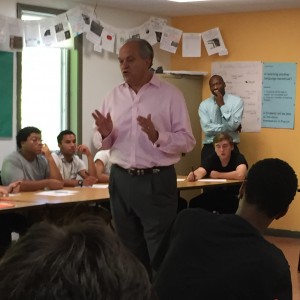
Former Mayor John DeStefano discusses his immigration policies with students in U.S. History and Documenting New Haven.
These things matter — but we think that getting out onto our site and into the community together is of real value, as well. One important reason is to support the amazing site and community-based learning experiences that our teachers create for our students. This fall, Ms. Anoh’s students are out practicing their French through work on our gardens. Mr. Richards’ U.S History course is focusing on a different local history lab in each unit of study; this month, they talked immigration policy with former Mayor John Destefano and dove into numbers on newcomers to our city collected by Data Haven. I got to take a hike up West Rock with our Documenting New Haven course, talking with students about how the edges of our cities change over time. Our seniors are building the research base that will result in their capstone senior projects, tackling the social and environmental justice challenges facing out city.
Doing this kind of work depends on so many skills, understandings, dispositions, and relationships. How do you manage a group of students differently when they are out of the classroom? What are the connections between local immigration trends and national policty issues? What community residents and experts will give their time to work with our students? Our monthly faculty meetings are a chance to build the capacity to mobilize our city and site as a learning lab.
But there’s more to these monthly staff meetings than building the ability to use our place as our classroom. When our staff are exploring our campus and community, they’re talking with each other and building relationships. They are learning about one another, and from one another –- recognizing and sharing the things that make them uniquely effective educators. They are coming to trust one another and understand each others’ perspectices. These monthly “faculty field trips” bring together nearly all our high school staff, and often engage the staff from our urban farm and environmental education center, as well. When we can make it work, we also get a bunch of community members and educators from other schools in the mix. There’s so much potential in this community of practice — and so much to learn from one another.
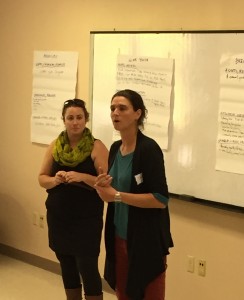
Jesse Delia and Ashton Killilea, both members of Common Grounds team, help facilitate a discussion between community partners and Common Ground staff.
Perhaps most importantly, being an effective school, and an effective organization, means being rooted in the city we call home. More than 65% of Common Ground students come from the City of New Haven; they live in every city neighborhood, and in 14 surrounding towns. Our community program participants are our neighbors, as well. How can we hope to meet this community’s needs, and welcome our students and ther families effectively, if we don’t know where they are coming from?
And so, we will keep getting out of our classrooms, and out onto our site and into the community. It’s one of the most important things we can do.
Are you a neighbor, eager to connect with Common Ground? Shoot me an email.


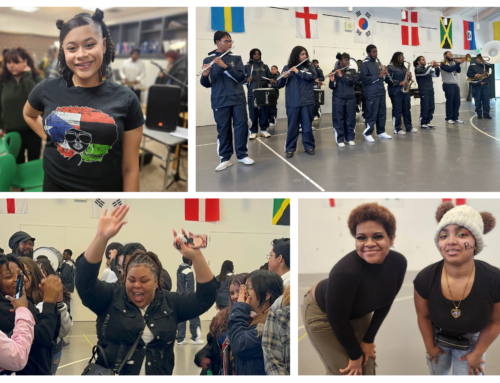
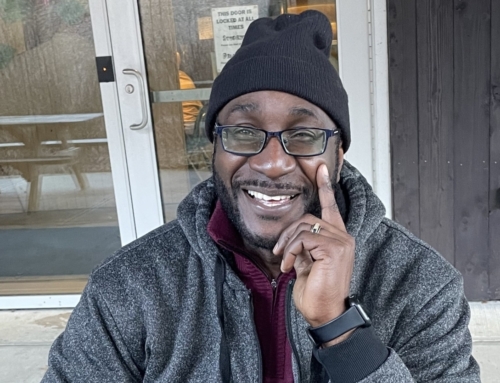
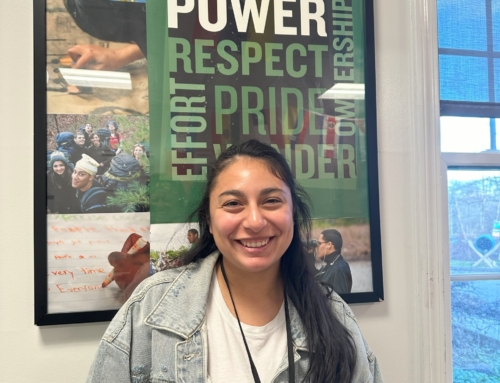
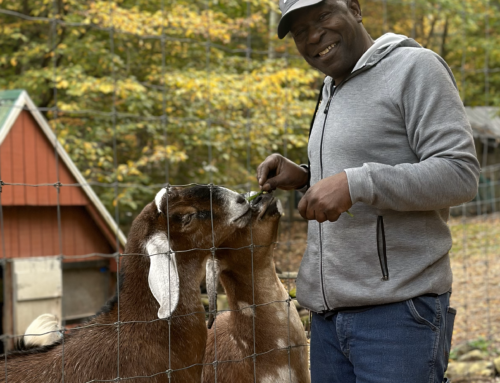
Leave A Comment